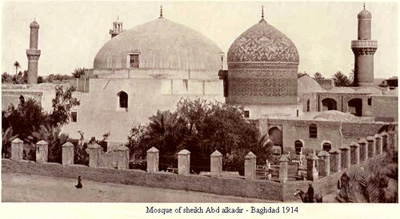|
Qadiriyyah
The Qadiriyya (), also transliterated Qādirīyah, ''Qadri'', ''Qadriya'', ''Kadri'', ''Elkadri'', ''Elkadry'', ''Aladray'', ''Alkadrie'', ''Adray'', ''Kadray'', ''Kadiri'', ''Qadiri'', ''Quadri'' or ''Qadri'' are members of the Sunni Qadiri tariqa (Sufi order). The tariqa got its name from Abdul Qadir Gilani (1077–1166, also transliterated ''Jilani''), who was a Hanbali scholar from Gilan, Iran. The order relies strongly upon adherence to the fundamentals of Sunni Islamic law. The order, with its many offshoots, is widespread, particularly in the non-Arabic-speaking world, and can also be found in Turkey, Indonesia, Afghanistan, India, Bangladesh, Pakistan, the Balkans, Russia, Palestine, China, Gladney, Dru "Muslim Tombs and Ethnic Folklore: Charters for Hui Identity"''Journal of Asian Studies'', August 1987, Vol. 46 (3): 495-532; pp. 48-49 in the PDF file. and East and West Africa. History The founder of the Qadiriyya, Abdul Qadir Gilani, was a scholar and preacher. Ha ... [...More Info...] [...Related Items...] OR: [Wikipedia] [Google] [Baidu] |
Qadariyah
Qadariyyah ( ar, قدرية, Qadariyya), also Qadarites or Kadarites, from (), meaning "power"); was originally a derogatory term designating early Islamic theologians who rejected the concept of predestination in Islam, ''qadr'', and asserted that humans possess absolute free will, making them responsible for their actions, justifying divine punishment and absolving God of responsibility for evil in the world. Some of their doctrines were later adopted by the Mu'tazilis and rejected by the Ash'aris. They argued that evil actions of human beings could not be decreed by God, as they would have to be if there was no free will and all events in the universe were determined by God. Qadariyyah was one of the first philosophical schools in Islam. The earliest document associated with the movement is the pseudoepigraphical text ''Risala'' attributed to Hasan al-Basri, which was composed between 75 AH/694 CE and 80/699, though debates about free will in Islam probably predate this text. ... [...More Info...] [...Related Items...] OR: [Wikipedia] [Google] [Baidu] |
Qadri
The Qadiriyya (), also transliterated Qādirīyah, ''Qadri'', ''Qadriya'', ''Kadri'', ''Elkadri'', ''Elkadry'', ''Aladray'', ''Alkadrie'', ''Adray'', ''Kadray'', ''Kadiri'', ''Qadiri'', ''Quadri'' or ''Qadri'' are members of the Sunni Qadiri tariqa ( Sufi order). The tariqa got its name from Abdul Qadir Gilani (1077–1166, also transliterated ''Jilani''), who was a Hanbali scholar from Gilan, Iran. The order relies strongly upon adherence to the fundamentals of Sunni Islamic law. The order, with its many offshoots, is widespread, particularly in the non-Arabic-speaking world, and can also be found in Turkey, Indonesia, Afghanistan, India, Bangladesh, Pakistan, the Balkans, Russia, Palestine, China, Gladney, Dru "Muslim Tombs and Ethnic Folklore: Charters for Hui Identity"''Journal of Asian Studies'', August 1987, Vol. 46 (3): 495-532; pp. 48-49 in the PDF file. and East and West Africa. History The founder of the Qadiriyya, Abdul Qadir Gilani, was a scholar and preacher. H ... [...More Info...] [...Related Items...] OR: [Wikipedia] [Google] [Baidu] |
Abdul Razzaq Gilani
ʿAbd al-Razzāq b. ʿAbd al-Qādir al-Jīlānī (c. Dhu al-Qi'dah 528 AH – 6 Shawwal 603 AH/9 September 1134 – 7 May 1207),''The works of Shaykh Umar Eli of Somalia of al-Tariqat al-Qadiriyyah.'' also known as Abū Bakr al-Jīlī or ʿAbd al-Razzāq al-Jīlānī (often simplified as Abdul-Razzaq Gilani) for short, or reverentially as Shaykh ʿAbd al-Razzāq al-Jīlānī by Sunni Muslims, was a Persian Sunni Muslim Hanbali theologian, jurist, traditionalist and Sufi mystic based in Baghdad. He received his initial training in the traditional Islamic sciences from his father, Abdul-Qadir Gilani (d. 1166), the founder of the Qadiriyya order of Sunni mysticism, prior to setting out "on his own to attend the lectures of other prominent Hanbali scholars" in his region. Ohlander, Erik S., “ʿAbd al-Razzāq b. ʿAbd al-Qādir al-Jīlānī”, in: ''Encyclopaedia of Islam, THREE'', Edited by: Kate Fleet, Gudrun Krämer, Denis Matringe, John Nawas, Everett Rowson. He is som ... [...More Info...] [...Related Items...] OR: [Wikipedia] [Google] [Baidu] |
Sheikh
Sheikh (pronounced or ; ar, شيخ ' , mostly pronounced , plural ' )—also transliterated sheekh, sheyikh, shaykh, shayk, shekh, shaik and Shaikh, shak—is an honorific title in the Arabic language. It commonly designates a chief of a tribe or a royal family member in Arabian countries, in some countries it is also given to those of great knowledge in religious affairs as a surname by a prestige religious leader from a chain of Sufi scholars. It is also commonly used to refer to a Muslim religious scholar. It is also used as an honorary title by people claiming to be descended from Hasan ibn Ali and Husayn ibn Ali both patrilineal and matrilineal who are grandsons of the Islamic prophet Muhammad. The term is literally translated to "Elder" (is also translated to "Lord/ Master" in a monarchical context). The word 'sheikh' is mentioned in the 23rd verse of Surah Al-Qasas in the Quran. Etymology and meaning The word in Arabic stems from a triliteral root connected wit ... [...More Info...] [...Related Items...] OR: [Wikipedia] [Google] [Baidu] |
Abu Saeed Mubarak Makhzoomi
Abu Saeed Mubarak Makhzoomi ( ar, ابوسعیدمبارک مخزومی), known also as Mubarak bin Ali Makhzoomi and Abu Saeed and Abu Sa'd al-Mubarak (rarely known as Qazi Abu Sa'd al-Mubarak al-Mukharrimi) was a Sufi saint as well as a Muslim mystic and traditionalist. He was an Islamic theologian and a Hanbali jurist based in Baghdad, Iraq. Abu Saeed was his patronym. Biography Abu Saeed Mubarak Makhzoomi was born in Hankar (the land of his Murshid) on 12th Rajab 403 Hijri but spent most of his life in Makhzum, a small town in Baghdad. He established Baab-ul-Azj, the famous madrasa of Baghdad whom he later handed over to his disciple and khalifah, Shaikh Abdul Qadir Jilani. Abu Saeed Mubarak Makhzoomi was also appointed as the chief justice but he preferred to renounce the worldly life. Thereafter he led his life as a mystic and devoted his time to the dhikr of Allah. He died on 11th Rabī’ al-Thānī 513 Hijri and was buried in Baab-ul-Azj, Baghdad. Sufi tradition A ... [...More Info...] [...Related Items...] OR: [Wikipedia] [Google] [Baidu] |
Abdul Qadir Gilani
ʿAbdul Qādir Gīlānī, ( ar, عبدالقادر الجيلاني, ʿAbd al-Qādir al-Jīlānī; fa, ) known by admirers as Muḥyī l-Dīn Abū Muḥammad b. Abū Sāliḥ ʿAbd al-Qādir al-Jīlānī al-Baḡdādī al-Ḥasanī al-Ḥusaynī (March 23, 1078February 21, 1166), was a Sunni Islam, Sunni Muslim preacher, asceticism, ascetic, Sufism, mystic, jurist, and kalam, theologian belonging to the Hanbali, Hanbali school, and the eponymous founder of the Qadiriyya tariqa (Sufi order) of Sufism.W. Braune, ''Abd al-Kadir al-Djilani, The Encyclopaedia of Islam'', Vol. I, ed. H.A.R Gibb, J.H.Kramers, E. Levi-Provencal, J. Schacht, (Brill, 1986), 69;"authorities are unanimous in stating that he was a Persian from Nayf (Nif) in Djilan, south of the Caspian Sea."John Renard, The A to Z of Sufism. p 142. Juan Eduardo Campo, Encyclopedia of Islam, p. 288. The Qadiriyya tariqa is named after him. He was born on March 23, 1078 (1 Ramadan, Ramdhan 470 AH) in the town of Na'if, Rezva ... [...More Info...] [...Related Items...] OR: [Wikipedia] [Google] [Baidu] |
Hagiography
A hagiography (; ) is a biography of a saint or an ecclesiastical leader, as well as, by extension, an adulatory and idealized biography of a founder, saint, monk, nun or icon in any of the world's religions. Early Christian hagiographies might consist of a biography or ', a description of the saint's deeds or miracles (from Latin ''vita'', life, which begins the title of most medieval biographies), an account of the saint's martyrdom (called a ), or be a combination of these. Christian hagiographies focus on the lives, and notably the miracles, ascribed to men and women canonized by the Roman Catholic church, the Eastern Orthodox Church, the Oriental Orthodox churches, and the Church of the East. Other religious traditions such as Buddhism, Hinduism, Taoism, Islam, Sikhism and Jainism also create and maintain hagiographical texts (such as the Sikh Janamsakhis) concerning saints, gurus and other individuals believed to be imbued with sacred power. Hagiographic works, especia ... [...More Info...] [...Related Items...] OR: [Wikipedia] [Google] [Baidu] |
Mausoleum Of Abdul-Qadir Gilani
fa, مزار غوث, , native_name_lang = ara / fa , image = الحضرة القادرية منظر عام.jpg , image_upright = 1.4 , alt = , caption = The mausoleum complex in 2016 , map_type = Iraq Baghdad#Iraq#Middle East#Asia , map_size = 240 , map_alt = , map_relief = 1 , map_caption = Location in Baghdad , coordinates = , coordinates_footnotes = , religious_affiliation = Sunni Islam , locale = , location = , deity = , rite = Qadiriyya Sufi , sect = , tradition = , festival = , cercle = , sector = , municipality = , district = , territory = , prefecture = , state = , province = , region ... [...More Info...] [...Related Items...] OR: [Wikipedia] [Google] [Baidu] |
Suleiman The Magnificent
Suleiman I ( ota, سليمان اول, Süleyman-ı Evvel; tr, I. Süleyman; 6 November 14946 September 1566), commonly known as Suleiman the Magnificent in the West and Suleiman the Lawgiver ( ota, قانونى سلطان سليمان, Ḳānūnī Sulṭān Süleymān) in his realm, was the tenth and longest-reigning Sultan of the Ottoman Empire from 1520 until his death in 1566. Under his administration, the Ottoman Empire ruled over at least 25 million people. Suleiman succeeded his father, Selim I, as sultan on 30 September 1520 and began his reign with campaigns against the Christian powers in central Europe and the Mediterranean. Belgrade fell to him in 1521 and the island of Rhodes in 1522–23. At Mohács, in August 1526, Suleiman broke the military strength of Hungary. Suleiman became a prominent monarch of 16th-century Europe, presiding over the apex of the Ottoman Empire's economic, military and political power. Suleiman personally led Ottoman armies in ... [...More Info...] [...Related Items...] OR: [Wikipedia] [Google] [Baidu] |
Ottoman Empire
The Ottoman Empire, * ; is an archaic version. The definite article forms and were synonymous * and el, Оθωμανική Αυτοκρατορία, Othōmanikē Avtokratoria, label=none * info page on book at Martin Luther University) // CITED: p. 36 (PDF p. 38/338) also known as the Turkish Empire, was an empire that controlled much of Southeast Europe, Western Asia, and Northern Africa between the 14th and early 20th centuries. It was founded at the end of the 13th century in northwestern Anatolia in the town of Söğüt (modern-day Bilecik Province) by the Turkoman tribal leader Osman I. After 1354, the Ottomans crossed into Europe and, with the conquest of the Balkans, the Ottoman beylik was transformed into a transcontinental empire. The Ottomans ended the Byzantine Empire with the conquest of Constantinople in 1453 by Mehmed the Conqueror. Under the reign of Suleiman the Magnificent, the Ottoman Empire marked the peak of its power and prosperity, as well a ... [...More Info...] [...Related Items...] OR: [Wikipedia] [Google] [Baidu] |
Baghdad
Baghdad (; ar, بَغْدَاد , ) is the capital of Iraq and the second-largest city in the Arab world after Cairo. It is located on the Tigris near the ruins of the ancient city of Babylon and the Sassanid Persian capital of Ctesiphon. In 762 CE, Baghdad was chosen as the capital of the Abbasid Caliphate, and became its most notable major development project. Within a short time, the city evolved into a significant cultural, commercial, and intellectual center of the Muslim world. This, in addition to housing several key academic institutions, including the House of Wisdom, as well as a multiethnic and multi-religious environment, garnered it a worldwide reputation as the "Center of Learning". Baghdad was the largest city in the world for much of the Abbasid era during the Islamic Golden Age, peaking at a population of more than a million. The city was largely destroyed at the hands of the Mongol Empire in 1258, resulting in a decline that would linger through many centu ... [...More Info...] [...Related Items...] OR: [Wikipedia] [Google] [Baidu] |
Safavid Dynasty
The Safavid dynasty (; fa, دودمان صفوی, Dudmâne Safavi, ) was one of Iran's most significant ruling dynasties reigning from 1501 to 1736. Their rule is often considered the beginning of modern Iranian history, as well as one of the gunpowder empires. The Safavid Shāh Ismā'īl I established the Twelver denomination of Shīʿa Islam as the official religion of the Persian Empire, marking one of the most important turning points in the history of Islam. The Safavid dynasty had its origin in the Safavid order of Sufism, which was established in the city of Ardabil in the Iranian Azerbaijan region. It was an Iranian dynasty of Kurdish origin, but during their rule they intermarried with Turkoman, Georgian, Circassian, and Pontic GreekAnthony Bryer. "Greeks and Türkmens: The Pontic Exception", ''Dumbarton Oaks Papers, Vol. 29'' (1975), Appendix II "Genealogy of the Muslim Marriages of the Princesses of Trebizond" dignitaries, nevertheless they were Turkis ... [...More Info...] [...Related Items...] OR: [Wikipedia] [Google] [Baidu] |




.jpg)



